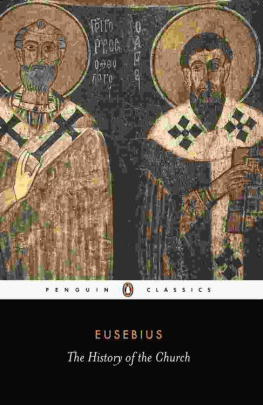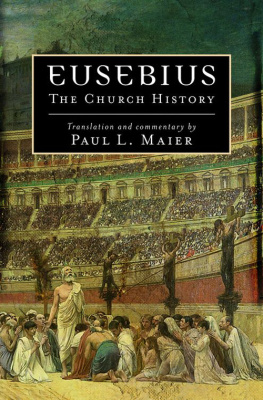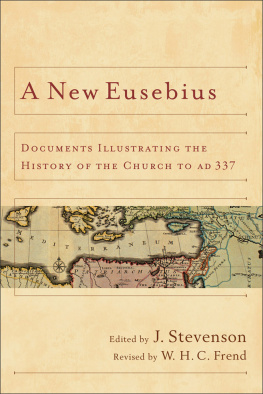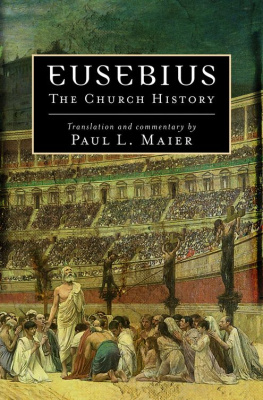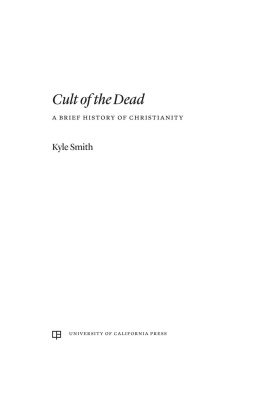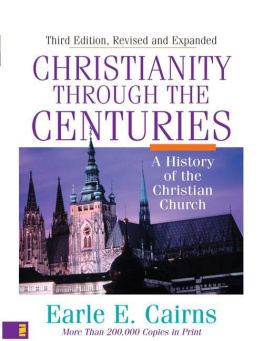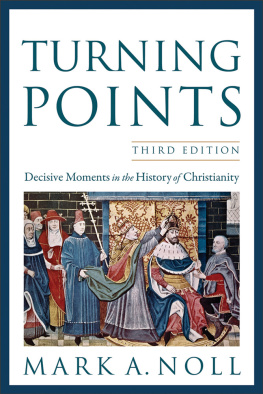

THE HISTORY OF THE CHURCH
EUSEBIUS ( AD c . 260339) was a Greek Christian writer, often called the Father of Ecclesiastical History. He was born in Palestine and educated at Caesarea, the city of which he later became bishop. Eusebius voluminous literary remains may be grouped into four categories: the historical, the apologetic, the Biblical and the dogmatic. The Ecclesiastical History comprises ten books, covering the period from the foundation of the Church to the defeat of Licinius in 324. A Preparation for the Gospel , in fifteen books, shows that Christians rightly prefer Judaism to paganism, and its continuation, the Proof of the Gospel , shows how the Christian religion is the fulfilment of the Old Testament. Among Eusebius other works are the Onomasticon , gazetteer of Bible sites, Commentary on the Psalms , of which only fragments remain, and the two books Against Marcellus . Sometimes termed the Christian Herodotus, Eusebius has earned legitimate fame as the historian of Christian antiquity.
G. A. WILLIAMSON was born in 1895 and was a Classical Exhibitioner at Worcester College, Oxford, graduating with a First Class Honours degree. He was Senior Classics Master at Norwich School from 1922 to 1960. He also translated Josephus: The Jewish War (1959) and Procopius: The Secret History (1966) for the Penguin Classics. He died in 1982.
ANDREW LOUTH , born in Lincolnshire and brought up in the north of England, studied theology at the universities of Cambridge and Edinburgh. From 1970 to 1985 he was Fellow and Chaplain of Worcester College, Oxford, and University Lecturer in Theology, teaching principally patristics. From 1985 to 1995 he was at Goldsmiths College, University of London, latterly as Professor of Cultural History. Since 1996 he has been at the University of Durham, where he is now Professor of Patristic and Byzantine Studies. He is the author of several books, including Denys the Areopagite (1989) and Maximus the Confessor (1996). He has also edited Early Christian Writings for the Penguin Classics.
EUSEBIUS
THE HISTORY OF THE CHURCH FROM CHRIST TO CONSTANTINE
Translated by G. A. Williamson
Revised and edited
with a new introduction by
Andrew Louth
PENGUIN BOOKS
PENGUIN BOOKS
Published by the Penguin Group
Penguin Books Ltd, 80 Strand, London WC2R 0RL, England
Penguin Putnam Inc., 375 Hudson Street, New York, New York 10014, USA
Penguin Books Australia Ltd, 250 Camberwell Road, Camberwell, Victoria 3124, Australia
Penguin Books Canada Ltd, 10 Alcorn Avenue, Toronto, Ontario, Canada M4V 3B2
Penguin Books India (P) Ltd, 11 Community Centre, Panchsheel Park, New Delhi 110 017, India
Penguin Books (NZ) Ltd, Cnr Rosedale and Airborne Roads, Albany, Auckland, New Zealand
Penguin Books (South Africa) (Pty) Ltd, 24 Sturdee Avenue, Rosebank 2196, South Africa
Penguin Books Ltd, Registered Offices: 80 Strand, London WC2R 0RL, England
www.penguin.com
This translation first published 1965
Reprinted with revisions and new editorial matter 1989
27
Copyright G. A. Williamson, 1965
Revisions and new editorial matter copyright Andrew Louth, 1989
All rights reserved
Except in the United States of America, this book is sold subject to the condition that it shall not, by way of trade or otherwise, be lent, re-sold, hired out, or otherwise circulated without the publishers prior consent in any form of binding or cover other than that in which it is published and without a similar condition including this condition being imposed on the subsequent purchaser
EISBN: 9781101487921
Contents
Foreword to the Revised Edition
The translation given here is that of the first edition, G. A. Williamsons clear and readable version, altered only in a very few places, mainly for editorial reasons. As is (or was) normal, Greek names are Latinized in their translation from Greek to Latin script (e.g., Eusebius, not Eusebios). Hebrew names, when they refer to Old Testament figures, are given in the form (often based on the Hebrew) familiar from English Bibles (e.g., Joshua, not Jesus).
The footnotes simply contain (mainly biblical) references, except for a few cases where it is necessary to identify to whom Eusebius is referring, or to explain a point of translation. All other commentary (apart from that in the appendices) is to be found in the Whos Who in Eusebius (pp. 427), as most of what the reader will want to know concerns the people who appear in Eusebius pages. The Whos Who also contains a few items on such matters as Easter, the Septuagint and so on, to which the reader is directed by cross-references; otherwise the value of cross-referring is taken for granted.
The introduction, Whos Who and appendices are intended for the general reader and student: no elaborate justification is given of the opinions stated. The bibliography lists works that will take the reader further (as do the entries in the Whos Who). For further commentary, the reader is referred to the notes to A. C. McGifferts translation of Eusebius in Nicene and Post-Nicene Fathers , Second Series, vol. 1 (1904), and to Lawlor and Oultons commentary in vol. 2 of their translation of Eusebius The History of the Church and Martyrs of Palestine (London, 19278). Much information, supplementary to the Whos Who, is to be found in the Oxford Dictionary of the Christian Church , ed. F. L. Cross and E. A. Livingstone (2nd rev. edn, Oxford, 1983) and in the much older, but still very valuable, Dictionary of Christian Biography , ed. W. Smith and H. Wace, 4 vols. (London, 187787).
Finstock
September, 1988 | Andrew Louth |
Introduction
Eusebius life
Eusebius was born in the early 260s, probably in Caesarea, which was to be the scene of his activities for most of his long life. Originally a small town on the Palestinian coast of the Mediterranean with a fortified harbour, known as Stratos Tower after the dynast of Sidon who had built it, it became a Greek city during the struggles for Palestine between the Seleucid and Ptolemaic kings. About 100 B.C. it became part of the Hasmonean kingdom and probably received a large influx of Jewish settlers, but forty years later Pompey made the city once again a Gentile city. Stratos Tower then came under the rule of Herod the Great, who ruled as king of Judaea 374 B.C.: he rebuilt the city on a grandiose scale as a Hellenistic capital and Roman metropolis and renamed it after Augustus Caesar. Henceforth he was regarded as its founder. When Judaea became a Roman province, Caesarea became its capital. It was raised to the status of a Roman colony by Vespasian, who settled veterans there. The importance of Caesarea was further enhanced by Jerusalems decline in significance after the Jewish wars (A. D.6673 and 1325): in 135 Jerusalem became a pagan city, Aelia Capitolina, from which Jews were banned on pain of death. The growing importance of Persia in the third century made Caesarea even more important to the Romans as a focal point for campaigns against Persia. In the fourth century it was even deemed worthy to be, briefly, the residence of one of the Roman Emperors, Maximin Daia.
By the third century Caesarea had a population of 100,000. A pagan city under the protection of the goddess Tyche (Fortune), it had a cosmopolitan population with a large Jewish community, an almost equally large Samaritan community, and a growing Christian presence. Origen the great Christian theologian had spent the last twenty years of his life there and had established a kind of Christian academy that had attracted Christian pupils from all over the East. This academy, with its library, was consolidated by Pamphilus, a great admirer of Origen (though he had never known him), who settled in Caesarea and set about preserving Origens heritage by making copies of all his voluminous works and continuing his labours on the text of the Scriptures. This Pamphilus was Eusebius adored mentor: Eusebius became Pamphilus pupil and collaborated with him on his last work, the Apology for Origen , composed while Pamphilus was in prison awaiting martyrdom during the Great Persecution at the beginning of the fourth century. Eusebius preserved Pamphilus memory after his death, both in his account of his martyrdom in Martyrs of Palestine and in his (lost) Life of Pamphilus , and, more personally, by adding Pamphilus name to his own so that he was known as Eusebius Pamphili , Pamphilus Eusebius.
Next page
